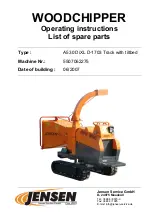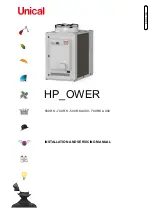
54
9.3 Refrigerant charge
WARNING
Do not inject refrigerant liquid into the LP side
of the circuit. Be very careful, and charge the
circuit properly.
If the charge is insufficient, the efficiency of
the unit will be lower than expected. In the
worst of cases the LP pressure switch may be
activated, resulting in the halting of the unit.
In the presence of an excess charge, the
condensing pressure will rise (in the worst
of cases, the HP pressure switch may
be activated, resulting in the stop of the
equipment), and the consumption will increase
as well.
WARNING
It is strictly forbidden to use the compressor
as a vacuum pump to drain the plant.
Fill the refrigeration circuit after it has been drained for maintenance
purposes (leaks, replacement of the compressor etc.). The amount
of the charge is indicated on the plate affixed to the unit.
Before refilling, it is important to drain and de-hydrate the circuit, thus
obtaining a minimum abs. pressure value of 50 Pa.
Inject the refrigerant fluid before removing the vacuum, then fill the
circuit up to 90% of the total gas requirement (in liquid form). The
appliance must be filled through the filling valve on the liquid line, on
the outlet side of the condenser.
It is recommended to connect the refrigerant cylinder to the filling
valve on the liquid line, and to arrange it in such a way as to inject
only liquid refrigerant.
Then start the compressor and let the gas flow from the cylinder, up
until the liquid flow, which can be observed through the sight glass,
is limpid.
9.4 Compressor
Compressors are delivered with the necessary charge of lubricating
oil. During normal operation, this charge is sufficient for the whole
life of the unit, providing that the efficiency of the refrigeration circuit
is satisfactory and if it has not been overhauled.
If the compressor needs to be replaced (following a mechanical
failure or if burnt), contact one of Service Centers.
WARNING
Compressors use polyester oil. During
maintenance operations on the compressor, or
if you have to open the refrigerant circuit in any
point, remember that this type of oil is highly
hygroscopic, and accordingly it is important
that it is not left exposed to the weather for
prolonged periods, as this would require the
replacement of the oil.
9.5 Condenser
The condenser’s coils consist of copper pipes and aluminium fins.
In the presence of leaks caused by any damage or shock, the coils
shall be repaired or replaced by one authorised Service Center. To
ensure the effective and correct operation of the condenser coils, it
is important to keep the condenser’s surface perfectly clean, and to
check that there is no foreign matter, such as leafs, wires, insects,
waste etc. If the coil becomes dirty, there is an increase in the
absorption of electric energy. Furthermore, the maximum pressure
alarm may be activated and may halt the unit.
WARNING
Be careful not to damage the aluminium fins
during cleaning.
The condenser must be cleaned with a LP compressed air jet, parallel
to the aluminium fins, in the direction opposite to the air circulation.
To clean the coil you can use also a vacuum cleaner, or a jet of water
and soap.
9.6 Fans
The fans of the condenser, of axial type, are complete with impeller
with aerodynamic profile blades and a cylindrical nozzle. The motor’s
bearings are lubricated forever.
Before starting the appliance, after any maintenance operations
involving the disconnection of 3-phase connections, check that the
direction of rotation of the fans is the one indicated by the arrow
(upward air current). If the direction of rotation is wrong, invert two
of the three supply phases to the motor.
9.7 Dehydrating filter
The refrigeration circuits are provided with dehydrating filters.
The filter clogging is marked by the presence of air bubbles in the
sight glass, or by the difference between the temperatures measured
downstream from and upstream of the drying filter. If, once the
cartridge has been cleaned, there are still some air bubbles, the
appliance has lost a part of the refrigerant charge in one or more
points, that must be identified and serviced.
9 - Maintenance (continued)









































